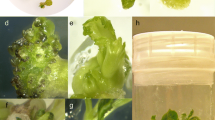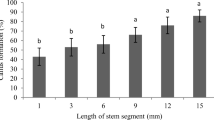Abstract
A reliable and efficient protocol for the regeneration of fertile plants derived from leaf base segments of young in-vitro-grown oat seedlings has been developed successfully. Callus induction and shoot regeneration were achieved when the basal region of young seedlings was cultured on auxin-containing medium. Callus induction efficiencies as well as regeneration frequencies were correlated with the developmental stage and the genotype of the explants. In five different genotypes of oat, an average of 25 plants per explant could be produced and for the most responsive genotype more than 50 regenerants per explant could be regenerated reproducibly. This high regeneration potential makes oat leaf bases a very attractive target for transformation.
Similar content being viewed by others
Author information
Authors and Affiliations
Additional information
Received: 6 May 1997 / Revision received: 10 August 1997 / Accepted: 15 September 1997
Rights and permissions
About this article
Cite this article
Gless, C., Lörz, H. & Jähne-Gärtner, A. Establishment of a highly efficient regeneration system from leaf base segments of oat (Avena sativa L.). Plant Cell Reports 17, 441–445 (1998). https://doi.org/10.1007/s002990050422
Issue Date:
DOI: https://doi.org/10.1007/s002990050422




